
TIJDSCHRIFT VOOR ECONOMISCHE EN SOCIALE GEOGRAFIE
Scope & Guideline
Connecting Research with Global Economic and Social Landscapes
Introduction
Aims and Scopes
- Economic Geography and Local Development:
The journal emphasizes the study of economic systems and local development strategies, examining how regional economies adapt to global changes and local initiatives. This includes topics like tourism, infrastructure development, and the role of local actors. - Social Dynamics and Spatial Inequalities:
TESG explores the social dimensions of geography, focusing on issues such as migration, housing, gentrification, and urban inequalities. The journal seeks to understand how social factors are intertwined with spatial practices and policies. - Regional Identity and Cultural Geography:
The journal investigates the formation and transformation of regional identities and cultural landscapes. It examines how territorial identities are constructed and how they influence social relations and economic activities. - Environmental Sustainability and Climate Change:
There is a strong emphasis on sustainability, particularly in relation to climate change and environmental behavior. The journal publishes research on local responses to global environmental challenges and the implications for regional planning. - Methodological Innovations in Geography:
TESG encourages the use of innovative methodologies in geographical research, including digital tools, spatial analysis, and qualitative approaches. This focus on methodological rigor enhances the robustness of research findings.
Trending and Emerging
- Urban Resilience and Recovery:
An increasing number of studies focus on urban resilience, particularly in the context of recovery from crises such as the COVID-19 pandemic. This theme explores adaptive strategies and the role of community engagement in building resilient urban environments. - Intersectionality and Social Justice:
There is a noticeable trend towards examining intersectionality in social justice contexts, exploring how various identities (e.g., gender, race, class) intersect with spatial practices and contribute to inequalities. - Digital Geographies and Technology's Influence:
Research on digital platforms, smart cities, and technological impacts on geography is gaining traction. This trend reflects the growing importance of technology in shaping economic and social interactions. - Climate Change Adaptation Strategies:
The journal is increasingly publishing research on local adaptation strategies to climate change, focusing on how communities respond to environmental challenges. This includes studies on sustainable practices and policy implications. - Transnational and Cross-Border Dynamics:
Emerging themes include the exploration of transnational connections and cross-border dynamics, particularly in the context of migration and economic interactions, highlighting the complexity of global interconnectedness.
Declining or Waning
- Traditional Industrial Geography:
There has been a noticeable decrease in publications focused on traditional industrial geography, particularly studies that merely describe industrial locations without engaging with broader social or economic dynamics. - Rural Studies with Limited Scope:
Research on rural areas has shifted towards more nuanced discussions of rural-urban interactions and local development, leading to a decline in studies that focus solely on rural issues without considering their urban counterparts. - Quantitative-Only Approaches:
There seems to be a waning interest in purely quantitative studies that do not integrate qualitative insights. The journal’s trend towards interdisciplinary approaches suggests a move away from research that relies solely on quantitative data. - Globalization in a Static Context:
Earlier themes that addressed globalization in a static manner, focusing on its impacts without considering dynamic processes and local responses, are becoming less frequent as researchers adopt more complex frameworks. - Overly Theoretical Discussions:
There is a decline in the publication of papers that engage in overly theoretical discussions without empirical backing. The journal is increasingly valuing empirical research that offers practical insights.
Similar Journals
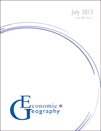
ECONOMIC GEOGRAPHY
Exploring the Intersection of Economy and SpaceECONOMIC GEOGRAPHY, published by Taylor & Francis Ltd, is a premier journal in the fields of Economics and Geography, acclaimed for its rigorous exploration of the spatial dynamics of economic processes. With an ISSN of 0013-0095 and E-ISSN of 1944-8287, this journal boasts a remarkable standing reflected in its 2023 Q1 category rankings in both Economics and Econometrics and Geography, Planning and Development. Positioned within the top percentile of its categories in Scopus rankings, it is a vital resource for researchers, professionals, and students seeking to understand the complex interplay between economic activities and geographical contexts. Published in the United Kingdom, the journal maintains a rich archive dating back to its inception in 1972, making it a significant repository of knowledge for those examining economic geography across decades. While not an open-access journal, its in-depth articles provide crucial insights into pressing economic issues and contribute to advancing scholarly discourse in the discipline.
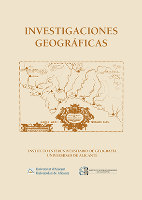
Investigaciones Geograficas-Spain
Innovating geographical discourse from Spain to the world.Investigaciones Geográficas-Spain is an esteemed academic journal published by the Universidad de Alicante, dedicated to advancing the fields of geography, planning, and development as well as earth and planetary sciences. With its commitment to open access since 1983, the journal ensures that research is readily available to a global audience, facilitating knowledge dissemination and collaborative discourse. As reflected in its 2023 Scopus rankings, it holds a commendable position within the Q3 category in both Earth and Planetary Sciences and Geography, Planning and Development, making it a noteworthy resource for scholars and practitioners in these disciplines. The journal's scope encompasses diverse geographical research, aiming to address pressing environmental and societal challenges through empirical studies and theoretical advancements. By contributing to the knowledge reservoir from Spain and beyond, Investigaciones Geográficas-Spain serves as a vital platform for researchers, professionals, and students seeking to enrich their understanding of geographical phenomena.
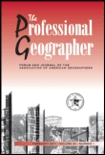
PROFESSIONAL GEOGRAPHER
Elevating the Discourse in Geography and Earth SciencesPROFESSIONAL GEOGRAPHER is a prominent journal in the fields of geography and earth-surface processes, published by Routledge Journals, Taylor & Francis Ltd. With a rich history dating back to 1949 and continuing through 2024, it serves as a vital platform for researchers, professionals, and students to explore and disseminate groundbreaking research and insights within the geographical sciences. The journal holds a respectable impact factor, placing it in the Q2 quartile for both Earth-Surface Processes and Geography, Planning and Development as of 2023, highlighting its importance in these critical academic areas. The journal ranks #273 out of 821 in Geography and Planning and #70 out of 179 in Earth and Planetary Sciences on Scopus, reflecting its robust contribution to advancing knowledge in social sciences. Although it does not currently offer open access options, it still provides invaluable content that influences pedagogy and research in geography. Its comprehensive scope invites a wide range of geospatial topics, encouraging interdisciplinary dialogue and collaboration across the global academic community.

Area Development and Policy
Pioneering research for transformative area development.Area Development and Policy is a prominent open-access journal published by Routledge Journals, Taylor & Francis Ltd, focusing on significant contributions to the fields of geography, urban studies, public administration, and environmental science. Launched in 2014 and located in the United Kingdom, this journal has quickly garnered a reputation for excellence, achieving a Q1 ranking in several categories, including Geography, Planning and Development, and Nature and Landscape Conservation as of 2023. Researchers and academics benefit from its broad scope, which encompasses various dimensions of area development and policy-making, while facilitating the dissemination of cutting-edge research through its open-access format. With an exceptional Scopus ranking—particularly within Urban Studies (#32/279)—the journal serves as a crucial platform for scholars seeking to advance discourse in these fields. As it converges its focus through 2024 and beyond, Area Development and Policy continues to be an essential resource for professionals and students dedicated to understanding the complexities of regional development and the policies that shape our environments.
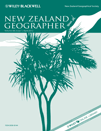
New Zealand Geographer
Charting New Territories in Geographic ScholarshipNew Zealand Geographer, published by WILEY, is a distinguished academic journal that has made significant contributions to the fields of geography, planning, and earth sciences since its inception in 1945. With a dedication to advancing knowledge through rigorous research and critical analysis, the journal encompasses a broad spectrum of topics relevant to both regional and global geographies. This journal is currently indexed in Scopus, achieving commendable rankings in multiple categories, including a Q3 status in both Earth and Planetary Sciences and Geography, Planning and Development for 2023, highlighting its relevance and standing within the academic community. Although it does not currently offer open access, its commitment to providing insightful and impactful content ensures that it remains a vital resource for researchers, professionals, and students alike seeking to deepen their understanding of geographical phenomena. The journal's ongoing publication until 2024 continues to foster scholarly discourse, making it an essential platform for innovative research in geographic studies.

Documents d Analisi Geografica
Illuminating Contemporary Geographical Challenges and SolutionsDocuments d'Anàlisi Geogràfica is a distinguished academic journal published by Universitat Autònoma de Barcelona, focusing on the fields of geography, planning, and earth-surface processes since its inception in 1988. With an Open Access policy implemented in 2012, the journal aims to facilitate the widespread dissemination of geographical research and insights, accessible to a global audience. Currently ranked in Q3 for both Earth-Surface Processes and Geography, Planning and Development categories, it serves as a vital platform for researchers, practitioners, and students to share their findings and enhance knowledge in these critical fields. The journal is indexed in Scopus, where it stands at rank #470 in Social Sciences and #106 in Earth and Planetary Sciences, reflecting its growing impact in relevant academic communities. Based in Barcelona, Spain, Documents d'Anàlisi Geogràfica continues to contribute substantially to geographical scholarship by exploring contemporary issues and advancements in a rapidly evolving world.
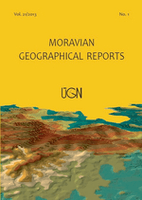
Moravian Geographical Reports
Exploring the Frontiers of Geography and Planetary ScienceWelcome to the Moravian Geographical Reports, an esteemed Open Access journal published by SCIENDO, dedicated to advancing the fields of Earth and Planetary Sciences as well as Geography, Planning and Development. Established in 1993, this journal has steadily built a reputation for disseminating high-quality research, evidenced by its 2023 Q2 ranking in both relevant categories and an impressive Scopus percentile ranking of 72. With a dedicated editorial board and an expanding global readership, the Moravian Geographical Reports serves as a vital platform for researchers, professionals, and students alike, fostering dialogue and collaboration across various dimensions of geographical and environmental studies. Since its shift to Open Access in 2013, it has significantly enhanced the accessibility and reach of its published works, making crucial research findings available to a broader audience. The journal continues to thrive as a significant contributor to the geographical and earth sciences discourse during its converged years from 1993 to 2024.
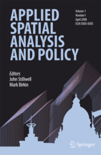
Applied Spatial Analysis and Policy
Innovating methodologies for a better tomorrow.Applied Spatial Analysis and Policy, published by Springer, is a leading journal dedicated to advancing knowledge in the field of spatial analysis and its application in policy-making. With an ISSN of 1874-463X and an E-ISSN of 1874-4621, this peer-reviewed journal has been at the forefront of geographical research since its inception in 2009 and continues to thrive with a convergence extending to 2024. As a recognized publication in the Geography, Planning and Development category, it holds a commendable Q2 quartile ranking for 2023 and is positioned at rank #238 out of 821 in the Scopus classification, reflecting its strong impact and relevance within the academic community with a percentile of 71. The journal provides a robust platform for researchers and professionals to explore innovative methodologies and empirical studies that enrich spatial policy frameworks. While access to individual articles is not open access, its significant contribution to the field makes it a vital resource for anyone involved in spatial analysis and related disciplines.

Shima-The International Journal of Research into Island Cultures
Charting New Territories in Island ResearchShima - The International Journal of Research into Island Cultures is a distinguished academic platform dedicated to exploring the multifaceted cultural dynamics and social phenomena specific to island societies. Published by Macquarie University, Division of Humanities in Australia, this open access journal has been a vital resource since its inception in 2007. With an impressive H-index and a convergence period from 2017 to 2024, Shima occupies a significant niche in various disciplines, evident in its 2023 quartile rankings, including Q1 in History and Q2 in Cultural Studies, among others. The journal's robust impact is reflected in its notable Scopus ranks, positioning it favorably among peer institutions, particularly in History and Cultural Studies. Researchers, students, and professionals who are engaged in island studies, anthropology, and related fields will find Shima a valuable repository for contemporary research, innovative methodologies, and interdisciplinary insights that highlight the rich cultural narratives of island communities.

Geograficando
Navigating New Frontiers in Geography and BeyondGeograficando is a distinguished scholarly journal dedicated to the field of geography and its interdisciplinary applications, published by the Universidad Nacional de La Plata, in collaboration with the Facultad de Humanidades y Ciencias de la Educación. Since its establishment, this Open Access journal has made significant strides in advancing geographical research and discourse, enhancing visibility and accessibility for scholars around the globe since 2013. With an ISSN of 1850-1885 and an E-ISSN of 2346-898X, Geograficando provides a platform for innovative research articles, critical reviews, and case studies that address contemporary geographical challenges and promote sustainable development practices. The journal serves as a vital resource for researchers, professionals, and students alike, fostering a rich exchange of ideas and findings that contribute to both academic and practical advancements in the field.